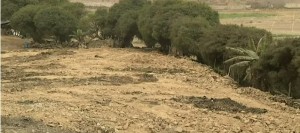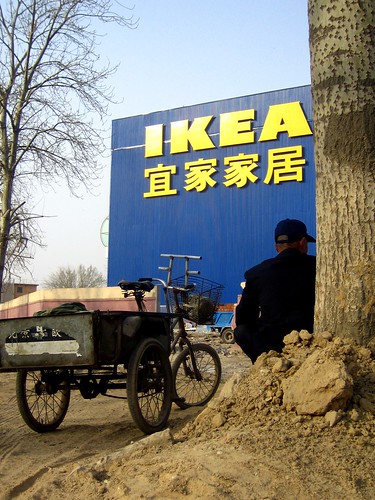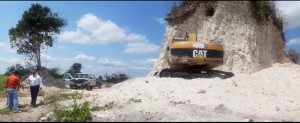
Maybe they didn’t realize how remarkable these places were. Maybe they just didn’t care.
Whatever the reason, fascinating ruins are leveled every year by a handful of ignorant developers and construction companies that give their entire industry a bad name. Just last week, a real estate firm in Peru allegedly bulldozed a 4,000-year-old temple at one of the country’s oldest archeological sites.
The most blatant and appalling destruction of ancient relics usually takes place in less developed countries, where rules protecting such sites are more difficult to enforce. This list of 5 demolished ruins offers a mere glimpse at the amount of heritage that’s been needlessly destroyed.
El Paraiso temple, Peru

Real estate developers last week allegedly smashed a 4,000-year-old temple, which stood six metres tall, in the El Paraiso archeological site.
This collection of relics, located just north of Lima, served as a religious and administrative centre long before the Inca Empire rose to power.
Marco Guilen, director of an excavation project at El Paraiso, told the Associated Press that those who destroyed the pyramid “have committed irreparable damage to a page of Peruvian history”.
The Peruvian government has filed criminal complaints against the two companies it claims were responsible.
Ancient tombs, China
Last month, five 3,000-year-old tombs were demolished to make way for a new railway route on the Chinese metro in Guangzhou city.
Archeologists were actually analyzing the site before the destruction took place. When one researcher arrived for work in the morning, he was shocked to see the tombs reduced to rubble, according to media reports.
A similar scenario played out five years ago. In 2007, about 10 ancient tombs – traced back to 220 AD – were ripped up by excavators during the construction of an IKEA in southeastern China.
Reuters reported that archaeologists believed the high-quality craftsmanship of the tombs indicated that they may have belonged to a wealthy family.
“The tops of some of the tombs were chopped off by bulldozers, disclosing some green bricks,” one witness of the destruction told reporters.
Nohmul complex, Belize
The largest Mayan pyramid in Belize’s Nohmul complex once stood almost 20 metres tall. Now, it’s a pile of dust and rubble.
Construction crews decimated this archaeological site in May, apparently to get more fill to build a road. The loss was especially tough for local residents, who had helped to restore the ancient structure. Nohmul, which means Big Mound, was one of only 15 ancient Maya sites important enough to be noted on the National Geographic World Atlas.
“The Institute of Archaeology is going to use this opportunity to really embark on a national awareness campaign for the preservation and protection of the country,” John Morris, associate director of research at Belize’s Institute of Archaeology, told National Geographic.
The contractor reportedly apologized for the destruction.
Village remnants, Bulgaria
People usually notice when a 10-metre pyramid is leveled or ancient tombs are reduced to shards. But sometimes, the destruction of important archaeological sites isn’t so obvious.
In 2011, construction crews pulverized the somewhat subtle remains of an 8,000-year-old village while building a road from Bulgaria to Greece. The demolition meant that archaeologists lost thousands of years of history, according to news reports.
A careless oversight? Maybe, but crews were apparently given accurate maps of the area with the archaeological sites marked.
Holy relics, Saudi Arabia

An expansion of the the Masjid al-Haram mosque in Saudi Arabia has led to the destruction of ancient sites, critics say.
Unfortunately, this progress has laid waste to some amazing archaeological sites. Critics have slammed the Saudi government for allowing important holy relics to be crushed as the mosque is built up. Also, development within Mecca (mostly glass skyscrapers and luxury shopping malls) has resulted in ancient sites being destroyed.
The Washington-based Gulf Institute estimates that 95% of Mecca’s millennium-old buildings have been decimated in the past two decades alone. The Independent has done some fascinating coverage on this issue.
Trails and tourism can help preserve history
The best way to protect something is help people appreciate it. By developing trail systems to ancient ruins and focusing on sustainable tourism programs, more travelers will be able to experience these remarkable sites. They’ll start to care about them. They’ll advocate for their protection and may even donate their hard-earned cash toward their restoration.
But keep such amazing places tucked away from travelers, and only a few academics will care if they’re bulldozed.
Of course, no amount of tourist-traffic would have prevented the demise of the Chinese tombs mentioned above. But what about the temple at the Nohmul complex in Belize, which hadn’t been developed for tourism? Would that structure have been demolished so easily if even a small amount of travelers visited it on a regular basis?
Too bad we’ll never know.
Do you prefer the trails less travelled?
Join like-minded trekkers by signing up for the S&TT e-mail list. Every week, you’ll get:
- Profiles of little-known hiking destinations
- Gear reviews for backpackers and hikers
- Feature articles on strange and off-beat hiking
Plus we’re 100% spam-free (and proud of it)



